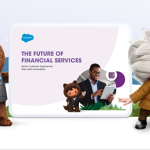2023 has been a uniquely challenging year for the insurance sector. Inflation, climate change, and supply chain issues have contributed to 10-year record high losses for some insurance companies.
To mitigate these pressures, forward-thinking insurance companies in Southeast Asia are looking for new ways to use artificial intelligence (AI) to create efficiencies across the value chain. And, in doing so, they’re finding new opportunities for growth.
In Singapore, for example, 50% of respondents to the Salesforce Connected Financial Services Report said they would switch to a new insurer if they offered a better digital experience.
However, face-to-face engagement and the human advisory experience is still important in Southeast Asia to build customer trust, especially in high impact and personalised products like Life and Health (L&H) insurance. While in the Property & Casualty (P&C) insurance business, there has been an increasing momentum to go full digital and touchless.
There is a generational aspect to this human/digital balance too. For example, the more seasoned generations typically prefer some human touch in the customer journey, while young consumers usually prefer more digital experiences.
Meanwhile, advancements in AI – particularly the rapid commercialisation of GenAI products through 2023 – have led insurers to adopt AI in various functions.
The Connected Financial Services Report
Insights from over 6,000 customers on why they switch financial services providers, and what they are seeking in digital and in-person experiences.


1. Adopt a data-first approach to leverage AI
Data has always been crucial for managing risk, determining claims, and setting premiums. In addition, it’s also a critical tool actuaries use to set the prices and rules that give insurers confidence that they can cover claims while staying solvent and regulatory compliant.
In this way, data is foundational to the insurance sector’s financial health and ability to mitigate risk. The advent of AI has heightened the importance of data in insurance to even higher levels, because AI is only effective when insurers use rich, interconnected, trusted datasets.
For example, Thailand-based online car insurer, Roojai, is able to utilise granular data sets to focus on optimising the customer journey from origin to conclusion. This has contributed to a 25% reduction in cost per conversion, and a 16% increase in conversions.
To adopt a similar data-first approach, insurers can use Salesforce Customer 360 to:
- Connect and unify customer data to enhance downstream applications with a 360-degree customer view. For example, Salesforce Customer 360 and MuleSoft connect your departments and customer data to provide a single, shared view of your customers.
- Benefit from generative AI without compromising data thanks to best-in-class security guardrails and enterprise security standards. For example, the Einstein Trust Layer uses guardrails like dynamic grounding, zero data retention, and toxicity detection, to protect data privacy and security and improve AI results accuracy.
- Grows deeper policyholder connections and increases productivity. For example, Data Cloud translates raw data into intelligence that enables insurance agents to visualise all customer engagement and activity, segment audiences, and prioritise cross-sell opportunities.
- Enhance customer engagement with personalised interactions and insights. For example, a connected CRM gives your teams access to a single source of customer data they can use to personalise content and experiences to meet your customers’ unique needs.
- Offer AI-driven insights, data analytics, and data visualisation across departments. For example, Tableau Analytics can be used to create intelligent experiences across the company with augmented analytics tools such as one-click storytelling with automated discovery, real-time recommendations, and narrative explanations with natural language generation.
Need help with your generative AI strategy?



2. Use automation technology to streamline operational processes
Swift underwriting is essential to deliver a seamless insurance sales experience to customers. This has been a challenge for insurance companies because underwriting often requires extensive amounts of information processing and decision-making. Imagine managing extensive data on coverage, benefits, and pricing across numerous insurance plans, conducting rule validation, and workflows across various applications. This can significantly lengthen turnaround times.
In addition, underwriting is more than just a desktop task. It involves collaboration with various partners and customers. For example, insuring a High Net Worth Individual (HNWI) in Asia might require assessments of health, lifestyle, and financials. This sometimes involves third-party services, which adds further complexity.
Similarly, commercial property insurance requires thorough property assessments, sometimes with onsite surveys by risk engineers. These comprehensive processes all contribute to longer turnaround times for the customer.
Insurers can streamline insurance processes by leveraging industry solutions. For example, Salesforce Financial Services Cloud automates underwriting and pricing, optimises workflows and collaboration, reduces turnaround time, and thus enhances sales conversion and Customer Lifetime Value (CLV) by empowering agents to focus on effective sales engagement and opportunities for cross-selling and up-selling.
In addition, Slack, brings conversations, collaboration, and automation together, making collaboration and communication between underwriters, sales agents, product managers, and third party service providers organised and aligned. Past underwriting data and knowledge are made easily accessible through Slack’s AI-powered search.
And real-time analytics and visualisation, along with natural language queries, empower employees to make informed decisions quickly.
Discover how finservs avoided disruption – and saved millions
Salesforce commissioned a Total Economic Impact™ study conducted by Forrester Consulting to explore the impact of Salesforce Customer 360 on financial services organisations. The study discovered decreased costs, improved customer engagement and employee satisfaction.



3. Recruit multi-generational customers with innovative digital engagement
As a new, affluent young customer group emerges in the region, insurance engagement is shifting from limited touchpoints to more frequent contact.
For example, Singapore-based insurer Singlife understands the importance of connecting with their customers on their preferred channels, and replaced post-delivered policy documents with engaging digital experiences. The aim is to make buying insurance as seamless an experience as shopping on any other online platform.
In addition, innovative telematics-based rewards, digital health concierges, health thought leadership, and engaging digital methods like embedded finance and gamified social media campaigns are all helping insurance companies to more effectively engage with customers online.
At the same time, social media platforms that attract diverse user groups enable insurers to personalise their marketing efforts.
Salesforce Marketing Cloud is one tool insurers are using to achieve this. It enables real-time, hyper-personalised engagement with native integration across digital platforms. Marketing Cloud also leverages Einstein AI for automated, customised customer journeys and sophisticated analytics for marketing performance and ROI insights.
This approach ensures insurers remain competitive and effective in a rapidly evolving market.
Discover the trends shaping the future of customer engagement
Insights from 14,300 consumers and business buyers on how AI, digital transformation, and macroeconomic trends are changing customer engagement.



Seize today’s opportunities with next-gen solutions
The insurance industry stands at a pivotal juncture, marked by both challenges and opportunities.
For insurers, the path ahead includes adopting trusted AI and data strategies, automating and augmenting insurance processes, and captivating and retaining multi-generational customers through diverse channels.
Leveraging platforms like Salesforce’s multi-cloud solutions will be crucial in integrating these initiatives, enabling insurers to not only satisfy current needs but also stay future proof.
This strategic approach will drive sustainable growth and resilience in the ever-evolving insurance landscape in Southeast Asia.
Empower your customers’ financial success with
CRM + AI + Data
Learn how Salesforce helps insurance carriers, agencies, and brokerages put customers at the centre of every interaction.



























